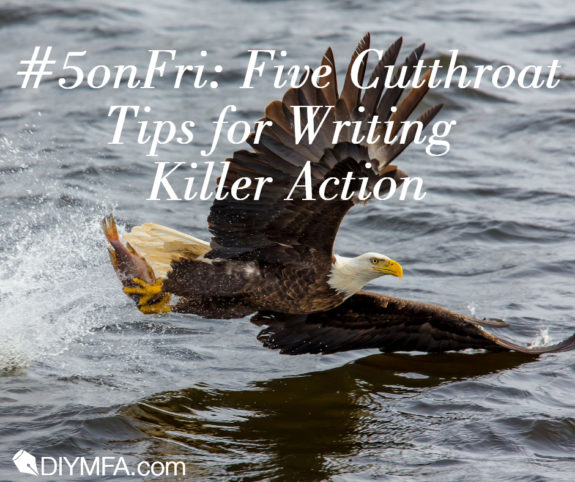Scenes depicting violence may prove difficult for some writers, since our artistic medium lacks a visual component. We must work doubly hard to keep the audience invested through vivid descriptions and sharp pacing. Smart authors also aim for techniques that channel tension and elicit emotion. In this post, we’ll outline five tips to help achieve that perfect action scene.
1) Reveal Character & Advance Plot
Violent scenes should propel the plot forward through strong characterizations. How a person deals with adversity says volumes about their morals and values. Consider the duel in Harry Potter and the Chamber of Secrets. The event solidifies the long-standing grudge between Malfoy and Harry, and helps with world building by introducing specialized weapons and tactics unique to the story’s milieu. In other words, the violence must tie into the story’s plot. Use violent scenes to resolve pending problems or create new ones. Thus, you shouldn’t be able to remove the action sequence and still have a cohesive narrative.
2) Show Vulnerability
Even though we want our hero to succeed, there will come a point in the action where he’ll need to falter. No one is invincible. Besides, invincibility is boring. Even Superman has his weaknesses, and the best violent scenes allude to those weaknesses even when the hero wins. This can come in the form of taunts from the villain that reveal the hero’s physical limitations or through the hero’s thoughts. A brief moment of reflection can show the audience how the events are affecting the hero internally.
Take a brief look into the hero’s mind to establish stakes. What’s on the line? What motivated your hero into action? Betrayal? Survival? Dishonor? A short reflection gives the audience time to catch their breath and discover how the action scene fits into the overall story.
Consider the Crazy 88’s fight scene from Kill Bill Volume 1. The number of foes is insurmountable. The Bride can’t possibly leave unscathed, but revenge and love for her lost child drive her forward. Meanwhile, the vicissitudes of her fate—the will she or won’t she succeed—keep the audience engaged.
Also, make sure the scene’s resolution leads to a transformation or revelation for the protagonist, and show your characters dealing with the aftermath of a fight. Give the sequence long-range consequences that aren’t easily reversible. Remember, healing from any violent situation takes time. Memories from the event will trigger reactions for days, months, or even years to come. Highlight the physical and emotional pain, and make sure to utilize that information to shape each characters’ behavior moving forward.
3) Use Vivid Verbs
Use strong verbs to truncate complex concepts. A violent fight scene is not the moment to wax poetic with flowery sentences. Commit to short phrases. Action verbs and tight phrasing will increase the pace, highlight danger, and promote urgency. The audience will notice this subconsciously as they read and become less likely to skip over the passage for fear of missing something vital. Reduce character dialogue and thought. Focus on movement, reflexes, and reaction. Use all five senses. This leaves the reader breathless and adds tension as their eyes fly across the page.
4) Shift the Focus
A writer can use point of view to highlight important events through shifts in focus. Consider this the literary equivalent of camera work—panning wide to establish danger or zooming in close on a character’s reaction. Here’s an example:
“The intruder bursts through the front door of the mansion. His muscular body fills the door frame with menace. He holds a Glock in front of him, but shots ring out from the darkness before he can fire. The man staggers. Blood trickles from his chest. His face twists with agony.”
Notice how the scene moves from a wide shot of the doorway to a half-shot on the intruder’s chest to a close-up on the man’s face. All of the action remains in third-person, but the passage shifts to where the action unfolds, adding nuance without losing concision.
5) Control the Pace
Keep the audience on the edge of their seats by playing with pace. Speeding up events, slowing things down, and compacting time creates a creepy sense of unease and will make your scene memorable. Use one or all three techniques in combination to create a tension-filled sequence that will leave the audience breathless. Get pulses racing by speeding up events.
- Keep the focus tight
- Keep details to a minimum
- Keep sentences short
- Reduce internal and external dialogue
- Use powerful verbs and maintain the active voice
Example: Virals by Kathy Reichs
- Unnerve the audience by slowing things down.
- Keep the focus wide
- Inundate the reader with details and descriptions
- Use longer sentences
- Use an internal monologue
- Use dialogue to provide reactions to action
Example: Hostile Witness by William Lashner
Create worry by compacting time. Omit the violent act. Force the reader to use his imagination. This unsettles the audience and causes them to envision the worst-case scenario.
- Show the POV character’s vulnerability
- Provide a strong precursory image leading into the violence
- Cut away and avoid describing the violent act itself
- Provide a vivid depiction of the aftermath
- Include a long-term consequence
Example: Talking to the Dead by Harry Bingham
As you work through these five steps, think about the message your scene will convey. After all, an action sequence isn’t about violence. It’s about the emotional growth of the protagonist as she encounters new obstacles. So use strong verbs, perspective, and pacing to distill that vulnerability into a killer scene that advances the plot and leaves the audience dying for more.
 Andrea J. Johnson is a writer and editor who specializes in genre fiction. She holds a creative writing M.F.A. from Seton Hill University and a copyediting certification from UC San Diego. Her craft essays have appeared on several websites, including Popsugar and Submittable, and she recently completed a cozy courtroom mystery novel. To learn more about Andrea’s work, follow @ajthenovelist on Twitter.
Andrea J. Johnson is a writer and editor who specializes in genre fiction. She holds a creative writing M.F.A. from Seton Hill University and a copyediting certification from UC San Diego. Her craft essays have appeared on several websites, including Popsugar and Submittable, and she recently completed a cozy courtroom mystery novel. To learn more about Andrea’s work, follow @ajthenovelist on Twitter.







